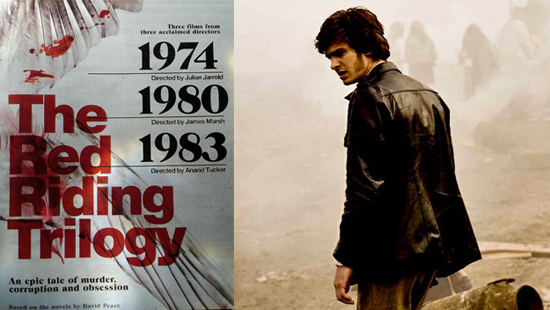
It's a crazy, mixed up world and we are thankful for movies, excluding The Spy Next Door and The Tooth Fairy, that offer proof. /Film's Weekend Weirdness examines such flicks, whether in the form of a new trailer for a provocative indie, a mini review, or an interview. In this installment, new trailers and a review of the Red Riding Trilogy, a noirish triptych of serial killer dramas imported from British television and being released stateside in February by IFC Films.
During a screening of the entire Red Riding Trilogy, with one intermission allotted for lunch, I found myself pondering the irony in three directors, one screenwriter, one author, tens of actors and three separate crews realizing a project that depicts humanity and bureaucracy at its most foul and irreversibly corrupt. A recent poster for the trilogy forebodingly reads, "Evil Lives Here," a tagline that would serve most of the work that exits Stephen King's skull; instead the "here" in Red Riding is Northern England in the '70s and early '80s, when a serial killer known as the Yorkshire Ripper carved a trail of female victims and set a mood and mythos ripe for social reflection.
If that sounds reminiscent of David Fincher's Zodiac, it is. Both that serial killer epic and Se7en are influential here by way of nightmarish imagery and the former's tediously realistic period detail and pre-computerized investigation routines. But it's much harder to seek comparison for the way the trilogy's storylines and characters—spread across three films, 1974, 1980, and 1983—communally bleed into each other, yet vary in quality, tone, and execution. The first film is a sexy, hardboiled mystery; the second a pitch-black procedural; the middling third a tale of redemption that borders on Hollywood melodrama. These differences make the trilogy appealing and slightly frustrating. Taken as a whole, it's a collaborative achievement that fans of crime cinema can feast upon.
In the Year of Our Lord 1974: Enough Cigarettes, Sex, and Murder to Make Andrew Garfield a Star
Rather surprisingly, the first installment of Red Riding has no less than four sex scenes, all of which feature 20something Brit actor Andrew Garfield. When he's not preoccupied in a bout of shagging, Garfield's mutton-chopped character, an ambitious newspaper journalist named Eddie Dunford, tends to have a cig and drink in hand. At first, it's difficult to gauge where the film is coming from, but Dunford's lifestyle choices are a youthful juggling act that blurs his well-meaning but naive obsession with a missing girl. He hopes to link the possible murder to two similar cases gathering dust and catch his big break.
In the proceeding two films, Dunford is a minor, peripheral character, but 1974 offers a star-making performance for Garfield, who will appear later this year in The Social Network. He portrays a young journalist drunk on romanticized, idealistic notions of the profession and still taps plenty of Raymond Chandler-like cool doing so. When the latest girl's body randomly surfaces, swan wings inexplicably sewn to her back, director Julian Jarrold (Brideshead Revisited) makes Dunford's hazy confusion our own, quickly plummeting us into a conspiratorial web of group-think involving the police, a powerful developer, elite society, and the media. Recurring themes of paternal betrayal and vacancy are planted beforehand, with Sean Bean as a delightfully sleazy yet dapper father figure-from-hell to Dunford.
Several readers have wondered if the Red Riding films work as stand-alone features—especially since they were originally made, and aired last year, for British television. Jarrold's 1974 works best in this regard. His use of 16mm in rendering a patina-heavy Yorkshire as a murderous landscape of pubs and misleading, at times ashen, hillside lends his film to memorable images. Dunford's tale is also the most singular and isolated—his noirish nighttime drives pay homage to David Lynch's Lost Highway—and the six-year gap between '74 and In the Year of Our Lord 1980 allows Jarrold to introduce several, complicit characters that are central later without worry for prior comparison. /Film Rating: 8/10


